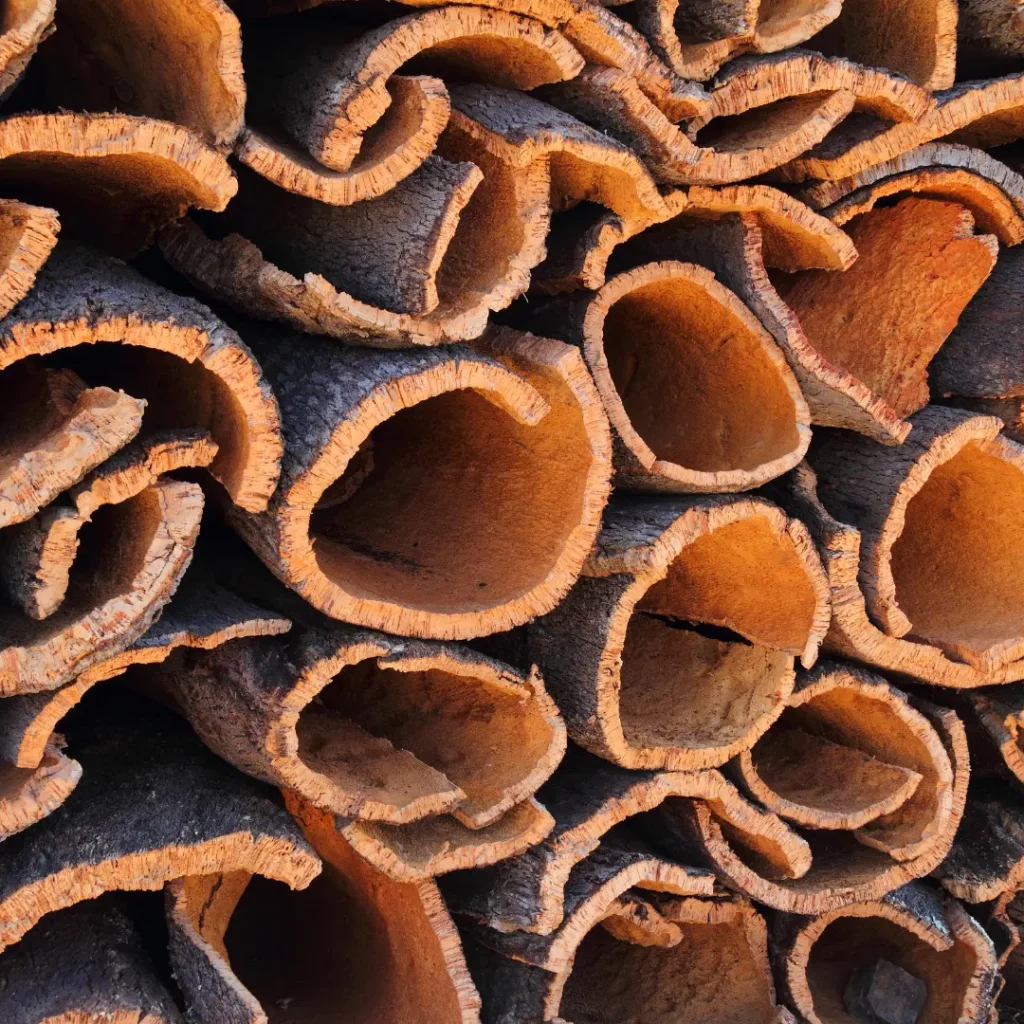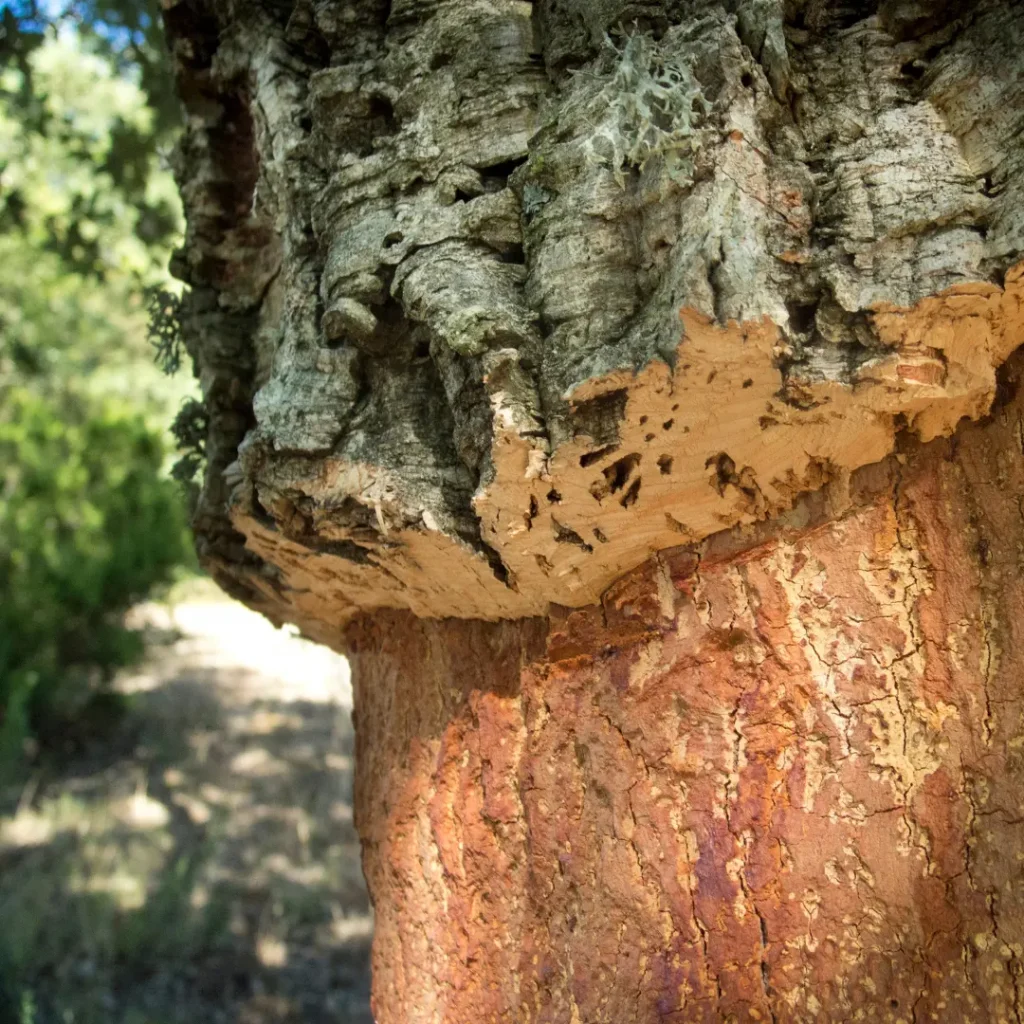Everyone has come across cork in their life, and you may be familiar with it due to wine. Have you ever considered cork in other contexts besides a glass of red wine? Or where it originates? Cork is a useful material that is just as sustainable as wood. This organic substance has a long history and many uses, so pop the cork, pour yourself a drink, and prepare yourself for a history lesson on the benefits of cork to humankind.
- What is Cork?
- Is Cork a Good Insulator?
- Is Cork Antimicrobial?
- Is Cork Toxic?
- Is Cork Sustainable?
- Cork Harvesting
- How Is Cork Made?
- Where Does Cork Come From?
- Where is Cork Grown?
- Are Cork Trees Endangered?
- Is Cork Recyclable?
- Is Cork Biodegradable?
- Is Cork Compostable?
- Why Should Cork be in Your Life?
- Wrapping Up
What is Cork?

What is Cork? To begin, we must define cork precisely. Cork is a naturally occurring, adaptable substance that originates from a tree, specifically the outer bark of mature cork oak. The Mediterranean region is home to many cork oak kinds of wood, which play a significant role in the regional economic and environmental ecosystems. Over 200 animal species and 135 plant species “find perfect conditions for survival in the cork oak forest,” according to Amorim Cork Composites. Because cork oak is a low-combustible timber, it absorbs enormous amounts of carbon dioxide and prevents soil erosion and fire dangers.
Portugal, which is home to the majority of the world’s cork oak forests and produces half of the world’s cork, has hundreds of businesses with a direct connection to the forests. These businesses include cork harvesting, storage, processing, or use or working with other aspects of the forest, such as ecotourism. For many years, these trees have supported and generated thousands of jobs for people.
Is Cork a Good Insulator?
Not only is cork an excellent thermal insulator, but it’s also an insulator for acoustics and vibrations. It’s also resistant to dampness and is a renewable item, making it a perfect all-around material.
Is Cork Antimicrobial?
Since cork is a natural product, it is subject to microbial contamination, just like most other raw materials. Its dampness resistance makes it more antimicrobial than many other materials, though. Often, the quality of the cork depends on the harvesters and quality control in transport and storage.
Is Cork Toxic?
Cork has no harmful effects on humans, so if you accidentally got some bits in your wine, there’s no need to worry. It’s a slow-combustion material, meaning that it doesn’t produce flame while burning, and the burning doesn’t spread. The smoke it releases while burning is also not toxic.
Is Cork Sustainable?
Cork is incredibly sustainable.
Cork is natural, sustainable, renewable, and environmentally friendly, making it an excellent material for our Earth’s future. Natural wine stoppers are made of cork, which is obtained from the bark of cork oak trees found in North Africa and Mediterranean Europe. Trees aren’t felled when the cork is harvested; instead, a skilled trade that has been passed down through the years meticulously removes their bark by hand.
The cork oak can live between 100 and 300 years. Thus this cycle can be repeated numerous times. When harvested, the typical cork tree typically produces 40–60 kg of cork, although older, more giant trees can produce hundreds of kilograms.
The fact that every cork is harvested from the tree by hand benefits the local workforce. The skilled traders carefully slice through the tree’s outer layer with a very sharp axe, taking care not to harm the living cells beneath, before slipping their axe underneath the strip and peeling the cork layer off.
Like any meticulous craft, this requires skill. Cork harvesting is one of the highest-paying agricultural occupations in the world as a result! This may be the cause of some cork goods’ higher price points.
The cork oak maintains the stability of the local ecosystems and landscapes during the regrowth period while also absorbing a significant quantity of carbon dioxide from the atmosphere. As a result, the forest endures in all its splendour.
Therefore, cork production and growth are sustainable practices.
Cork Harvesting
For the bark to regrow thick enough to be harvested, it takes nine to twelve years. The trees absorb up to five times more carbon from the atmosphere after harvest as they start to regrow their bark. They do this to support the photosynthesis that the regeneration needs.
The bark then traps the carbon. Cork trees typically remove 55 kilos of CO2 from the atmosphere for every kilogram of cork produced. The cork business supports extensive cork oak woods, totaling 2.7 million hectares, which helps the planet’s air become cleaner at astounding rates.


How Is Cork Made?
So, how does cork transition from tree bark to cork products? It’s incredibly fascinating. Over decades, the bark’s outer layer has been scraped numerous times. After each removal, a new type of natural cork product is produced. “Virgin cork” is taken from the initial removal, which happens after the tree has reached full maturity, which takes around 25 years. “Secondary cork” is the product of the second stripping.
Then, a range of uses for these two materials is made, ranging from things in the fashion industry to insulation for homes. The best cork, known as “media cork,” which you are familiar with as wine stoppers, is produced by the third removal, approximately fifty years after the first two removals.
A harvest occurs every nine years, during the spring and summer, when the tree grows the fastest. Harvesting during the cork tree’s growth season prevents damage to the tree, allowing it to continue maturing and producing cork for years to come. Cork trees are never chopped down during harvest. It’s critical to consider all aspects of how they are made and how they function in our lives as society increasingly looks for sustainable alternatives.

Where Does Cork Come From?
Quercus suber, also known as the cork oak tree, is a native of north and southwest Africa. It belongs to the same family as the common oak tree (Quercus robur) and the chestnut oak (Quercus montana).

Where is Cork Grown?
Cork is mainly produced in cork oak woods in Portugal and Spain, with smaller amounts also coming from Morocco, Algeria, Tunisia, Italy, and France.
The cork tree has evolved to develop a thick covering of bark to protect itself from the severe environment of the Mediterranean regions where it thrives (lots of sunlight, a little rain, and bushfires). Its bark is obtained sustainably and used to make goods made of cork.
Are Cork Trees Endangered?
Cork trees are not currently endangered, but laws and regulations are in place to protect them. Many wine producers are beginning to prefer other sealing methods, such as screw caps, so cork isn’t being used as much for this purpose anymore.
Is Cork Recyclable?
If you’re asking the question, “can you recycle cork?” the answer is yes! Cork is a durable material that can be recycled into various products, from craft supplies to flooring. You’d be shocked at how many items use cork.
Is Cork Biodegradable?
Yes, definitely! Remember that cork is an entirely natural material made from bark, so it’s biodegradable and does no harm to the Earth if thrown away. Cork is one of the best alternatives to leather and plastics.
Is Cork Compostable?
Another yes! Along with recycling them, you can also compost corks. Just be sure it’s genuine natural cork made from bark and doesn’t have any non-cork materials, like paint, on it. See our post “What is Composting” for more information.
Why Should Cork be in Your Life?
Cork is a highly sustainable material. Additionally, it might be advantageous for your house and health. It can provide peace of mind because it is a non-absorptive, hypoallergenic, heat and fire-resistant material. Cork flooring and insulation may safeguard you and your property for much longer than other options, which is good for the environment.
On a lighter note, studies have discovered that cork wine stoppers offer antioxidant advantages to wine, even though there hasn’t been much research done in this area. [1]
Cork should always be added to your home. It can be composted in the backyard. It is recyclable and biodegradable. Cork is a product that may be utilised in various ways in your daily life because of its versatility.

When you awaken, you may stroll across your cork-insulated flooring. With cork insoles, you could put on your sneakers. On your way out the door, you may grab your cork wristlet. You might choose cork wine bottle stoppers that helps Portuguese cork growers. You might use your cork mat and cork roller as a yoga mat. After that, return home without having to turn on your heater or air conditioner because the cork insulation has improved the temperature control of your walls. You may not even realise how integrated it already is in your life.
Wrapping Up
Finding this fantastic product in the market and integrating it into your daily life will get easier as it gains popularity due to the movement toward environmentally friendly alternatives. The next time you see a cork product, consider buying it for its benefits and take a moment to stop and think about how fantastic cork truly is.




